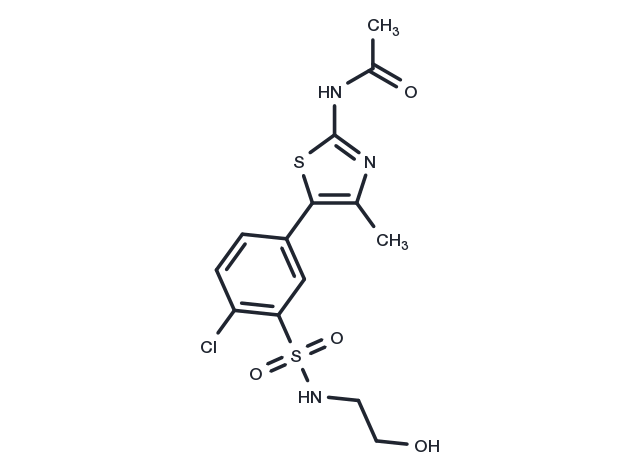Powder: -20°C for 3 years | In solvent: -80°C for 1 year
PIK-93 is the first potent, synthetic PI4K inhibitor with IC50 of 19 nM; inhibits PI3Kα with IC50 of 39 nM.

| パッケージサイズ | 在庫状況 | 単価(税別) | |||
|---|---|---|---|---|---|
| サンプルについてお問い合わせ | |||||
| 1 mg | 在庫あり | ¥ 8,500 | |||
| 5 mg | 在庫あり | ¥ 19,000 | |||
| 10 mg | 在庫あり | ¥ 28,000 | |||
| 25 mg | 在庫あり | ¥ 51,000 | |||
| 50 mg | 在庫あり | ¥ 85,500 | |||
| 100 mg | 在庫あり | ¥ 126,000 | |||
| 1 mL * 10 mM (in DMSO) | 在庫あり | ¥ 21,000 | |||
| 説明 | PIK-93 is the first potent, synthetic PI4K inhibitor with IC50 of 19 nM; inhibits PI3Kα with IC50 of 39 nM. |
| ターゲット&IC50 | PI3Kα:39 nM, PI4K:19 nM |
| In vivo | At concentrations ranging from 0.5 μM to 1 μM, PIK-93 impairs the stability of aggregates formed in differentiated HL60 cells treated with f-Met-Leu-Phe. In COS-7 cells, 250 nM of PIK-93 effectively eliminates the accumulation of the CERT-PH domain and FL-Cer in the Golgi apparatus. Additionally, in T6.11 cells, 300 nM of PIK-93 reduces Carbachol-induced translocation of TRPC6 to the plasma membrane and subsequent Ca2+ entry. The same concentration of PIK-93 also significantly inhibits the conversion of [3H]-labeled serine to endogenous sphingomyelin, indicating the critical role of PI4KIIIβ in the endoplasmic reticulum and Golgi apparatus for ceramide transfer and sphingomyelin synthesis regulation. Research demonstrates that PIK-93 possesses antiviral capabilities, inhibiting replication of the poliovirus and hepatitis C virus with EC50 values of 0.14 μM and 1.9 μM, respectively. PIK-93 effectively inhibits PI3Kγ and PI4KIIIβ, with IC50 values of 16 nM and 19 nM, respectively, and other PI3K members, including PI3Kα, β, and δ, with IC50 values of 39 nM, 0.59 μM, and 0.12 μM, while showing negligible inhibition effects on other kinases at concentrations up to 10 μM. |
| キナーゼ試験 | Assay of PI3Ks: IC50 values are measured using a standard TLC assay for lipid kinase activity. Kinase reactions are performed by preparing areaction mixture containing kinase, PIK-93 (2% DMSO final concentration), buffer (25 mM HEPES, pH 7.4, 10 mM MgCl2), and freshly sonicated phosphatidylinositol (100 μg/ml). Reactions are initiated by the addition of ATP containing 10 μCi of γ-32P-ATP to a final concentration 10 or 100 μM, and allowed to proceed for 20 min at room temperature. For TLC analysis, reactions are then terminated by the addition of 105 μL 1N HCl followed by 160 μL CHCl3:MeOH (1:1). The biphasic mixture is vortexed, briefly centrifuged, and the organic phase transferred to a new tube using a gel loading pipette tip precoated with CHCl3. This extract is spotted on TLC plates and developed for 3 hours–4 hours in a 65:35 solution of n-propanol:1M acetic acid. The TLC plates are then dried, exposed to a phosphorimager screen, and quantitated. Kinase activity is typically measured at 10–12 concentrations of PIK-93 representing two-fold dilutions from the highest concentration of 100 μM. |
| 細胞研究 | For actin staining, dHL60 cells are preincubated in suspension with PIK-93 or vehicle for 40 min, centrifuged for 5 min at 2000 rpm at room temperature in a J6-B centrifuge, resuspended in mHBSS containing the respective agent at the same concentration, allowed to stick to fibronectin-covered coverslips, and subjected to stimulation with a uniform concentration of 100 nM f-Met-Leu-Phe (fMLP) for 3 min. Cellsare fixed in 3.7% PFA and stained with 10 units/mL rhodamine-phalloidin for 15 min.(Only for Reference) |
| 別名 | PIK 93 |
| 分子量 | 389.88 |
| 分子式 | C14H16ClN3O4S2 |
| CAS No. | 593960-11-3 |
Powder: -20°C for 3 years | In solvent: -80°C for 1 year
DMSO: 39 mg/mL (100 mM)
You can also refer to dose conversion for different animals. 詳細
bottom
Please see Inhibitor Handling Instructions for more frequently ask questions. Topics include: how to prepare stock solutions, how to store products, and cautions on cell-based assays & animal experiments, etc.
PIK-93 593960-11-3 DNA Damage/DNA Repair Metabolism Microbiology/Virology PI3K/Akt/mTOR signaling Virus Protease ATM/ATR DNA-PK PI3K PI4K mTOR HSV Carbonic Anhydrase Phosphatidylinositol 4 kinases PI4 kinases Phosphoinositide 3-kinase inhibit Inhibitor PIK93 PIK 93 inhibitor
